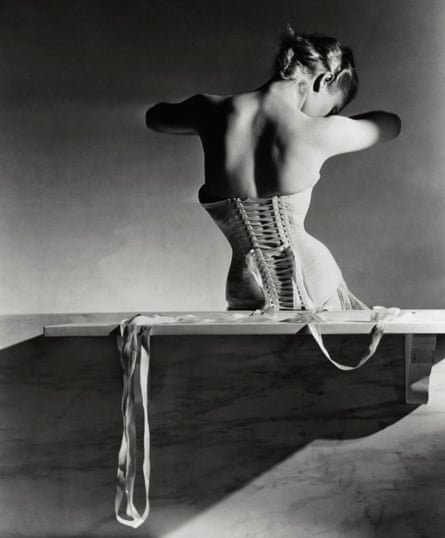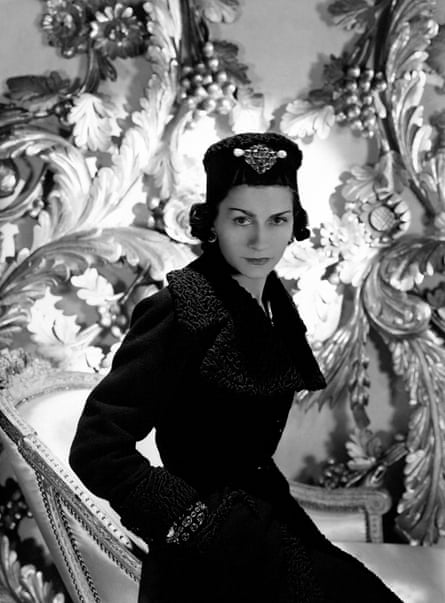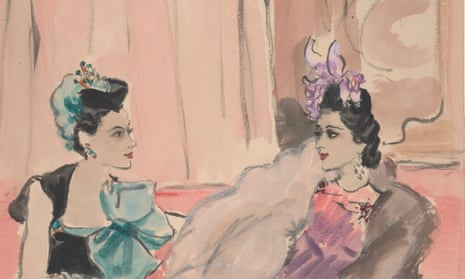PARIS.
Jewels, cathedral windows, cinerarias, metals – all set the pace for colouring in clothes. While many dark stuffs are used, these are illuminated not only by colour but by the glow and brightness of colour. It may only be the scarf which provides the blues, purples, reds, jades which must lighten the dress. More often it is a piece of decoration which is an integral part of the dress, as in the Mainbocher model, the gold embroidery of which has clearly a monarchical source. This is a black wool, and the ambassadorial embroidery is used for the front of the bodice, the belt, and the pockets. The cut of the skirt will be noted, with its close fit and spread above the knees. But its main characteristic is the brightness of the gold on the dark background.

Mainbocher emulates the cathedral window in a black silk afternoon dress with a wide, full vest made of multicoloured spangles. The twelfth-century glass suggestion is manifest. The spangles not only provide the colour but they have the jewel-like glitter of glass. These spangles appear on veils for the evening with fantastic suggestions of eyes and mouth, but as a rule they are confined to providing the decoration of dark dresses. With evening frocks they form brilliant, straight-cut jackets. A novelty is that instead of having a general shimmer they are arranged in plaids and checks, and the fact of having a design seems to lend them more point and more brilliancy. Here the colours are brilliant red, green, yellow, and white. The jacket is worn over a plain black crêpe dress. Little jackets are so frequent this season that they need some particular point.
Bands of Braid
Dark dresses for the afternoon are given various sorts of bright trimming, often on military lines and in the form of braiding. A dark crêpe may have bands of brilliant blue or green on it, like military braiding, with little buttons down the front to finish it off. Heim has several dresses trimmed with rows of colour – green, blue, and red, perhaps, – and both skirt and bodice may be thus adorned. Velvet is often used and suggests a last-century fashion when it is used round the edges of wide sleeves. Lace evening frocks may be finished with bands of velvet in the same colour, which throw up that of the lace and make it more vivid.
Evening dresses struggle for brilliancy, less by way of spangles, which are too familiar to them already, than by the choice of unusual colouring and by means of ribbon. Ribbon is made wide and often in many colours. Bright plaids are used, and there are many kinds of rich lamé ribbon. Ribbon is used for whole dresses and also for immense bows and sashes. Some of these bows dominate the character of the dress and are set on the side or back to give a sash or bustle effect. Their stiffness enables the pattern to be broken up and yet kept in place, as needed. Some of the rarer colours in evening frocks are ox-blood-coloured velvets, black combined with a bright blue velvet top, a close-fitting sapphire blue. With plain black velvet the requisite brilliancy is obtained by diamanté buttons, but these are used with discretion, only providing little twinkling points of light. Deep bright blue, petunia pink, cerise and green used together, egg-plant and plum shades, golden yellows are among the colours used by this designer.
Chanel draws attention to the colour of an evening dress by making the full skirt of brown tulle and the bodice in gold rose and blue lamé. This divides up the dress and makes a point of the waistline. Gold short coats have something of the same effect. It is not enough for these to be plain gold. Some of them look like Italian wallpaper, having a large gold pattern on a black ground. Some are of black taffetas with little gold spots. Others are lacquered in scarlet on a silver ground. They are contrasted as violently as possible with the dark skirts.

Colour is sometimes brought out by using the same tone in two contrasting materials. Lace and velvet may be used in about equal proportions in a red evening dress. Chanel uses this style in a fairly high-necked evening dress with the shoulders bare. Mainbocher lends what is almost colour to a black crêpe dress with a basque and wide hem of shiny satin. Both basque and hem are cut on circular lines, so that they have a good deal of bounce. Lelong, on the other hand, makes black significant by reinforcing taffetas with tulle, the two substances reflecting light in similar ways. The dress has a plain taffetas bodice and skirt top, and broadens out into a very full tulle flounce to the feet. This designer also uses colour on a navy taffetas evening frock with a short fitted jacket. Narrow red stripes are encrusted from the waist to the edge of the skirt.
Suits are often dark and plain, but not even they escape the tendency to possess colour. When they remain colourless the hats are bright in compensation. Schiaparelli has a blue suit the fronts of which are embroidered in pyramids of light blue. A dark blue suit is worn with a cap, tilted well to one side, of wine red, embroidered in metal like a Turkish cap. Embroidery is used freely on many kinds of cap – from the smoking variety, slanted well on one side, to the high Russian cap with a tassel. Felt bags are being made with embroidery upon them, and these match vivid scarves also lavishly adorned. For hats, feathers, are on the increase, and jewels and clasps continue to trim everything and anything.

Comments (…)
Sign in or create your Guardian account to join the discussion